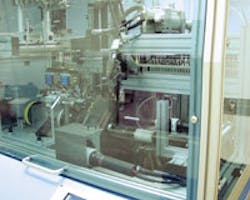When we open a lock hardware box, we usually take for granted all that goes into its manufacture. I recently had an opportunity to visit the Securitron Magnalock Corporation headquarters in Sparks, Nevada. During the tour of the facility, I was able to observe the production of Securitron E-Profile Maglocks. Finding it fascinating, I thought I would share the experience.
The magnetic lock is a Fail-Safe electronic locking device consisting of an electromagnet and an armature (strike) plate. The magnetic lock is installed onto jamb, usually the header. This is the part of the lock system that mounts onto the door. The armature plate is usually sex bolted along the top swing edge of the door. It is designed to self align flush against the face of the magnetic lock, and helps to ensure that the lock is holding at the rated holding force. The armature plate is made of a specialized non-permanent magnetic material that is plated to prevent oxidation.
The basic magnetic lock is made of three main components: the special ferrous material, the wire coil, and the electrical circuitry. The wire coils are constructed on a proprietary machine. This machine is designed to wind all of the various coils used in Securitron’s maglocks. These coils are known as the field. When the coil is energized, a magnetic field is created. When the coil surrounding the ferrous material is energized, the produced magnetic field is significantly amplified, a result of atomic particle alignment with each other that significantly enhances the magnetic flux density.
The strike plate size is dependent upon the size of the magnetic. There are formulas that determine the specific amount of mass required to properly interact with the magnetic field produced by the magnetic. In addition to size, the strike plate must be machined so its face provides a good mating surface for the magnetic lock.
The ferrous material becomes highly magnetized when voltage is applied. In plain English, the magnet when energized becomes strong enough to hold the armature plate with force sufficient to prevent separation up to a certain weight force. When power is removed, the lock loses it magnetic energy and is no longer able to hold the strike plate. The E-laminates and the strike plate are manufactured of special alloys that do not retain any appreciable amount of magnetism, enabling free release of the strike plate.
Note: When powering a magnetic lock, it is important to use the stated voltage to just saturate the lock without sending too much voltage to the coil. Over voltage causes thermal breakdown, which reduces the holding force of the magnet. The electronic circuitry built into the magnetic lock should prevent excess voltage.
The coil is made of a fine wire wound many times around a fixture. The coil is made into a rectangular shape so that it fits into an E-laminate stack. It is generally connected to a circuit board that allows for interface with an access/egress control system. Applying a voltage to the coil creates the magnetic field that magnetizes the E-laminate core.
Most magnetic locks are powered by either 12 or 24VDC. A magnetic lock will operate equally well with either voltage. However, for optimum performance and life expectancy, input power should be regulated around plus or minus 5 percent of the rated voltage.
The holding force of a magnetic lock is determined by a number of factors including the size, shape and type of the non-permanent magnetic material core, the wire size and number of windings of the coil, and the current. For the Securitron E-Profile Maglocks, the core E-laminate is made of a specialized ferrous metal. The E-laminates are made of a thinly sliced non-permanent magnetic material put together in a stack with a profile that closely resembles the capital letter “E”, hence the term E-laminate. They are used to make the actual core of the lock. The part that becomes magnetized when current is applied. The length and width of the E-laminates play a part in the maglock’s holding force. The 600 and 1200 pound holding force maglocks have different sizes and numbers of E-laminates.
So how does it all go together?
The E-laminates are placed onto a fixture to create the E-laminate stack. The Senstat lock option is also added at this stage.
The wire wrapped coil is then added to the stack and the combination is bound together using an industrial adhesive. The power wires are routed out the appropriate side of the laminates to match up with the circuit board.
The lock circuit board is ready to be attached. Coil power wires and lock power cord are soldered to the board and the board is fastened to the E-laminates. This “sub-assembly” is now ready for insertion into the lock mold.
The sub-assemblies are carefully positioned into a mold and filled with a suitable potting material. The potting material is both an electrical and magnetic insulator. The potting material cures into a hard strong sealant, resistant to chemicals, heat and vandalism.
Once the molded lock has cooled, the entire assembly goes through a machining process to produce a uniform surface. This surface is necessary for good matching contact with the strike plate. The machining process also removes any imperfections from the face of the lock.
After the lock has been machined it goes through a plating process to prevent the exposed portion of the E-laminate stack from oxidizing. During the plating process, the locks are individually tested to ensure the proper plating thickness and conductive properties.
At this point you have a working magnetic lock. The next step is to install the magnetic lock into an architecturally pleasing outside “can” or housing. After the final assembly, each maglock is thoroughly tested again.
The magnetic locks are boxed and await shipping.
Magnetic locks have been around since the early 1970s. They are considered a low maintenance lock. Securitron Magnalock Corporation MagLock’s are available with holding forces from 200 pounds to 1800 pounds. They can be ordered in a wide range of mounting styles that permits use of magnetic locks on most types of doors and frames.In addition, Securitron maglocks are available with a variety of options including door position, LED, Senstat, and/or tamper.
For more information, contact your local locksmith wholesaler or Securitron Magnalock Corp., 550 Vista Blvd. Sparks, NV 89434. Telephone: 775-355-5625 or 800-MAGLOCK. Fax: 775-355-5633. Website: www.Securitron.com.
Photography by Dennis Saxon, marketing manager, Securitron Magnalock Corp.






